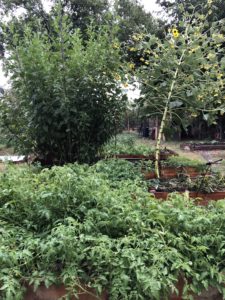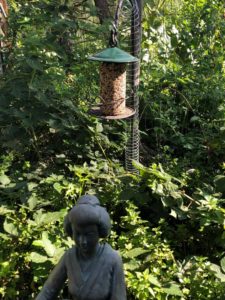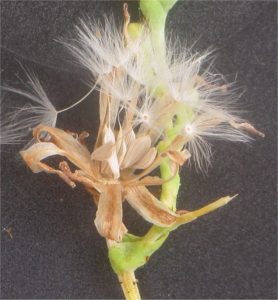I Quit…Trying to Manage My Garden
How Belle Starr’s Gardening Went from Stress and Mess to (Almost) Effortless.
By Belle Starr
I have been gardening for most of my adult life, some 43 years, and have always considered myself a fairly good gardener. My garden has provided food, flowers, exercise and sheer satisfaction. Looking back, there were times of great success.
I have marveled at plants that grow from volunteers and have often coaxed them to stay. I have watched beautifully coifed and perfectly balanced garden beds yield very little. And I have seen beds of questionable content growing interesting things blown in from elsewhere or dropped by critters.
There has also been disappointment, when my efforts failed, and seasons of overwhelm. I remember times when my thoughts went something like this: I either need to hire more help to keep my garden in check or I need to peel back my expectations and maybe even stop gardening altogether. Gardening is supposed to be fun, relaxing, enjoyable and give me great physical release. But I don’t remember anyone saying that gardening included worry, stress and self-doubt.
When I attended a permaculture class in the 90’s, I became very excited because it taught me to look at my garden differently. Permaculture is a design strategy that creates closed systems where nothing is wasted. It is ecological gardening that mimics and cooperates with nature; a practical method of developing ecologically harmonious, efficient and productive systems that provide more yield for less effort. What worked, and why became a new mantra as I revisited my approach and philosophy.
 Then I met a seed man, Bill McDorman, who became my husband. Again, my view of growing was challenged. Instead of buying seed every year, we were letting our plants go to seed and saving them. Making sure plants didn’t cross-pollinate so the seeds were “true to type” was an important component.
Then I met a seed man, Bill McDorman, who became my husband. Again, my view of growing was challenged. Instead of buying seed every year, we were letting our plants go to seed and saving them. Making sure plants didn’t cross-pollinate so the seeds were “true to type” was an important component.
Fast forward 15 years and many gardens later. Today we grow for pleasure, seeds and food. Yet I still find at times that I am stymied by what is happening in my garden. Too many sunflowers choking out everything, gangly tomatoes without tomatoes, coyote mint flourishing especially where it hasn’t been planted and invasive morning glories where the scarlet runner beans should be. A bed of crops is fruiting and another bed isn’t. At times, I still feel compelled to “fix” these natural issues.
 What a fruitless act — defying nature. Attempting to govern every situation was exhausting and disheartening. I began to ask how I could better step into a partnership with all this natural activity rather than attempting to control it.
What a fruitless act — defying nature. Attempting to govern every situation was exhausting and disheartening. I began to ask how I could better step into a partnership with all this natural activity rather than attempting to control it.
Enter Joseph Lofthouse, author and gardening maverick. I recently read his new book, Landrace Gardening, Food Security through Biodiversity and Promiscuous Pollination, According to Joseph, a landrace is a locally-adapted, genetically-diverse, promiscuously-pollinating food crop. Landraces are varieties that have been growing for generations, and thus are intimately connected to the land, ecosystem, farmer and community.
A key characteristic of landrace varieties is that they offer food security through their ability to adapt to changing conditions. The ability to adapt is critical. Changing climate, landscapes and seasons are obstructing our ability to propagate the varieties that we have always grown. New infestations and diseases challenge us. What Joseph points out is that nature inherently knows how to respond to changing conditions. If we honor that process while we grow our veggies, we will be amazed and humbled. This perspective was permaculture on steroids.
Joseph explains that, like me, he used to make sure nothing in his garden crossed. Now he encourages it, looking for the adapted varieties that taste great, and withstand various impacts such as hail storms, locust attacks, or drought. The best thing about landrace gardening, in Joseph’s opinion, is all the time he saves because he doesn’t keep copious records. Instead, he lets his thriving plants provide his data right then and there. This freeform gardening style allows for a type of observation that inspires Joseph to release control and play along with the results of natural cross-pollination.
Recently at a seed swap Joseph brought his landrace beans, all in one jar sporting every color of the rainbow. Instead of 25 different distinct types in different jars, he has his own unique mix selected for flavor, resilience, drought tolerance, growing patterns and ease in harvest. He grows all these beans together, considering it a benefit if they cross-pollinate which strengthens their genetics.
 Unlike traditional gardening, Joseph welcomes pests and disease into his garden. He wants his plants to be fully compatible with the existing ecosystem. Therefore, he allows his plants to live or die without his intervention. This is a strong departure from traditional gardening methods, even from the permaculture gardening that we were practicing.
Unlike traditional gardening, Joseph welcomes pests and disease into his garden. He wants his plants to be fully compatible with the existing ecosystem. Therefore, he allows his plants to live or die without his intervention. This is a strong departure from traditional gardening methods, even from the permaculture gardening that we were practicing.
Thinking about incorporating landrace gardening into our gardens might be a stretch. We have been taught that seed saving is hard, needs to be relegated to professionals and that if we save seeds ourselves we might make a mistake.
Joseph and Great American Seed Up co-founder Bill McDorman say, so what! Making mistakes is how tomorrow’s heirlooms are created. Take the example of butternut squash founded by an insurance salesman in his backyard in the northeast. It was born of a mistake, as was sweet corn, found by accident by a farmer in his field as he was tasting his flour corn.
The applications of this type of gardening are wide, varied and profound. Imagine a garden gathering where growers are discussing their new, innovative varieties that survived the elements and withstood some level of neglect. Envision a system where the work being done is no work at all, just the simple process of selection, looking for what survived and tasted great and planting it again. Could it really be this easy? I’ll let you know next year.
###
Joseph’s new book; Landrace Gardening will be available at the Great American Seed Up, November 4th and 5th, 2022 at North Phoenix Baptist Church in Phoenix. To register and for more information, go to greatamericanseedup.org/phoenixseedup.





